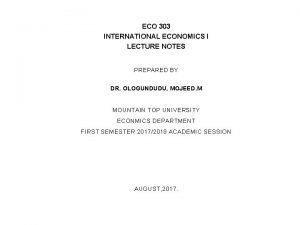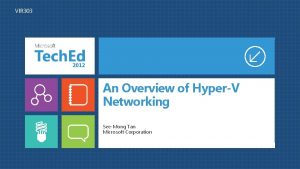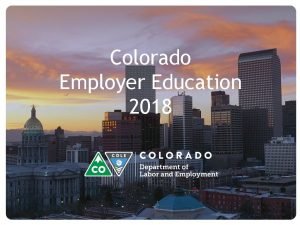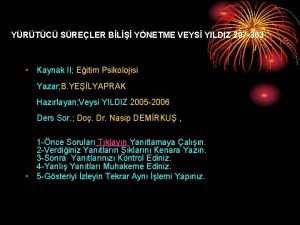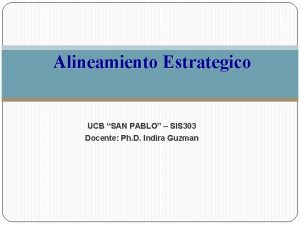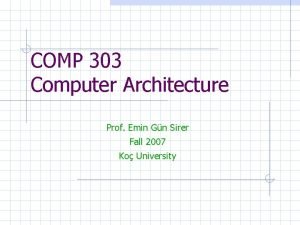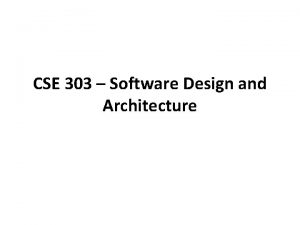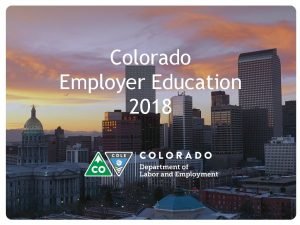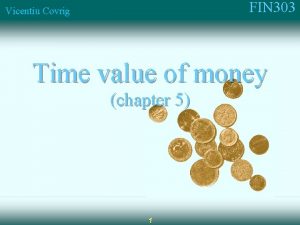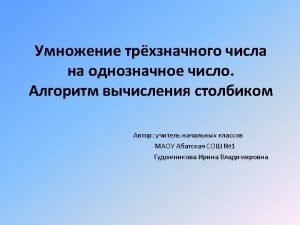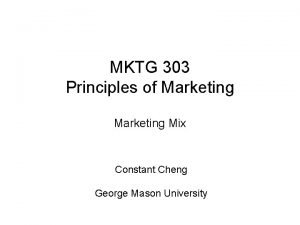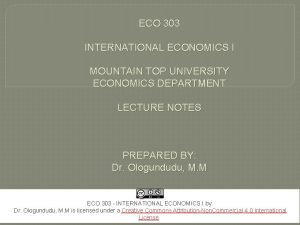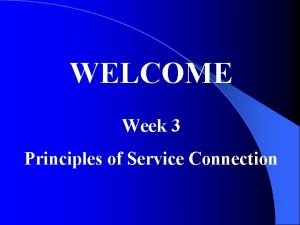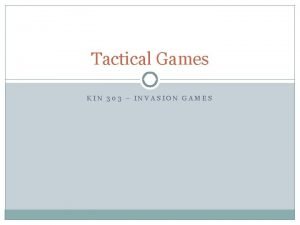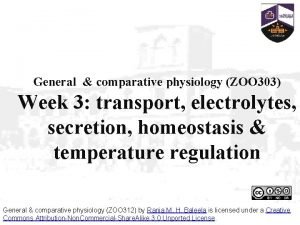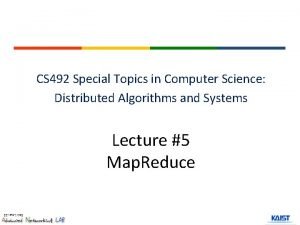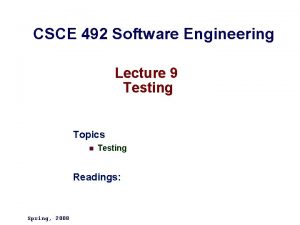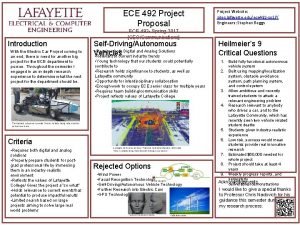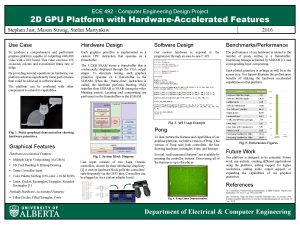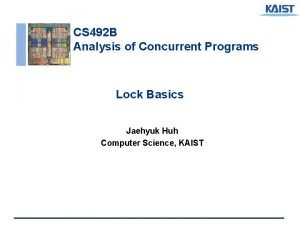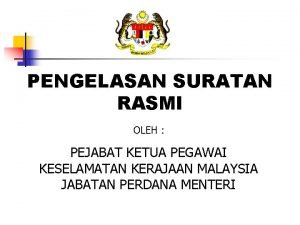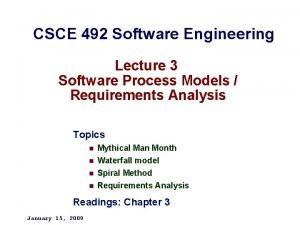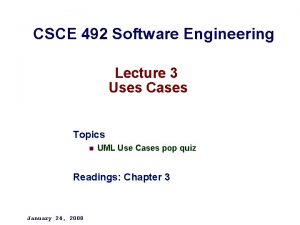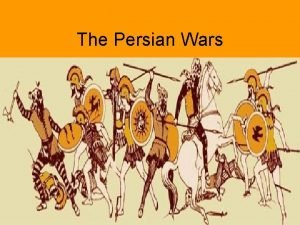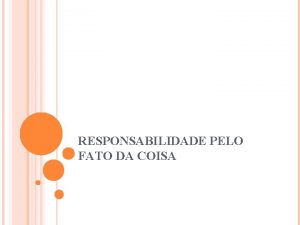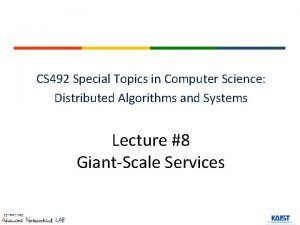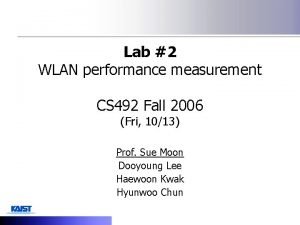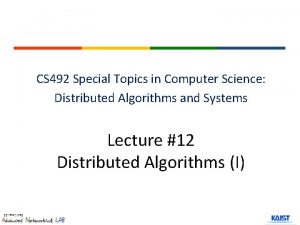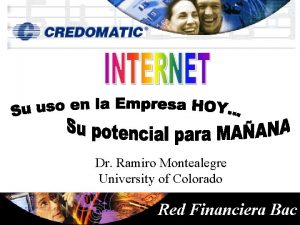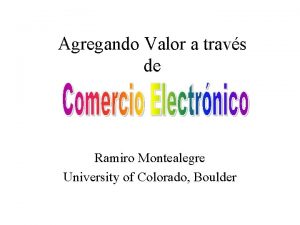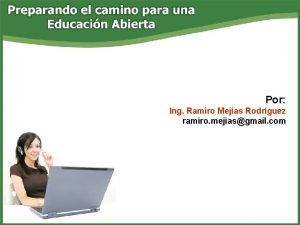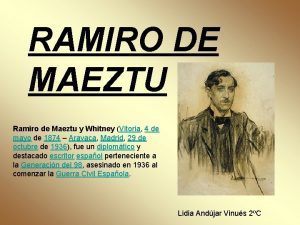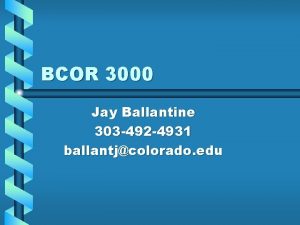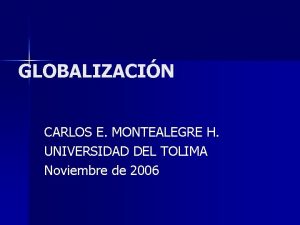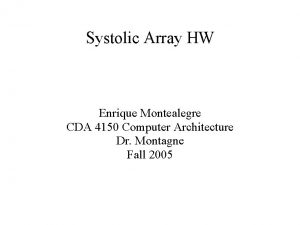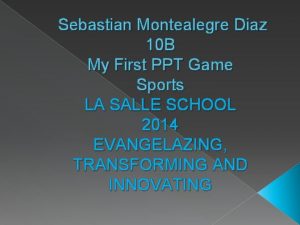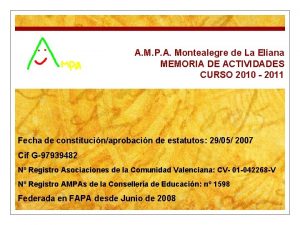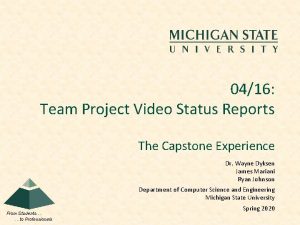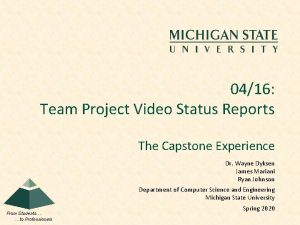Ramiro Montealegre Ramiro MontealegreColorado edu 303 492 0416
































- Slides: 32

Ramiro Montealegre Ramiro. Montealegre@Colorado. edu 303 -492 -0416, BUS 443 INSTITUTO de EMPRESA

BACKGROUND - IT and Internet knowledge - How is your company using the Internet today - Your role in your company Internet strategy - Expectations about this course

STUDENTS' BACKGROUND - NAME - DEGREE & MAJOR - WORKING EXPERIENCE - WHY REGISTERED FOR THE COURSE - EXPECTATION ABOUT THE COURSE

OBJECTIVES FOR THIS COURSE - The emergence of a GLOBAL INFORMATION INFRASTRUCTURE & ELECTRONIC COMMERCE - HOW to think about e-Business, and HOW to rethink business strategy - Present VIVID business examples to illustrate principles - Issues in MANAGING DATA, INFORMATION & KNOWLEDGE to EXPLOIT their potential for COMPETITIVE ADVANTAGE. - ROLE & RESPONSIBILITY of top and middle MANAGEMENT in e-Business DECISIONS.

TOPICS TO BE COVERED - Effects of IT on strategy and competition - Framing e-Business market opportunities - Managing in the physical and virtual worlds - Exploiting the virtual value chain - The customer interface for e-Business - Implementation of e-Businesses - Metrics for evaluating e-Businesses - International Issues of e-Business

TECH-WATCH: 2001 may mark the emergence of the Chief Strategy Officer, or CSO. The CSO's role is to ensure that an organization's e-business solutions are competitive. “An ideal CSO has a broad understanding of the marketplace and understands both technology and business needs. It could be someone who came up through the IT or marketing ranks. Ideally, it takes a jack-of-all-trades and a master of all of them to fill the job. " Tech. Republic, January 10, 2001

CASES TO BE ANALIZED - CNET - DELL ONLINE - AIR PRODUCTS - BOSTON. COM - AMAZON - PATAGON

THE "CASE METHOD" OF TEACHING - BASED ON ACTUAL COMPANY SITUATIONS - ILLUSTRATE ISSUES IN USING & IMPACT OF IT - CRITICAL ELEMENTS FOR LEARNING: PRIOR PREPARATION ATTENDANCE CAREFUL ANALYSIS PARTICIPATION IN CLASS

CLASS EVALUATION 1. Participation (50 %) a. Attendance and Contribution (30%) Student Class Attendance Preparation Participation b. Case study write-up (20 %) 2. Team work (50 %) a. Facilitation (30%) b. Critique (20%) Engagement Flow-of-Ideas Quality

Class Procedure for Facilitation/Critique Sessions First Team: Facilitation Second Team: Critique Instructor: (30 minutes) (15 minutes) A third view of the topic

References The E-business (R)evolution. D. Amor. Prentice Hall 2000 Internet Business Models and Strategies. A. Afuah and C. Tucci. Irwin/Mc. Graw-Hill 2000 Electronic Commerce: A Managerial Perspective. E. Turban, J. Lee, D. King, and H. M. Chung. Prentice Hall 2000 Electronic Comerse. J. Rayport and B. Jaworski, B. Mc. Graw-Hill 2001

For Tomorrow Please prepare: CNET 2000

CEDIR Program Summer 2001 Professor Ramiro Montealegre Effects of IT on strategy and competition

What is e-Business Technology-mediated exchanges between parties (individuals, organizations, or both) as well as the electronically based intra- or interoganizational activities that facilitate such exchanges. Rayport and Jaworski, 2000

How is e-Business Different from Traditional Commerce - Core strategic decisions are technology-based - A real-time competitive responsiveness - The store is always open - A technology-based customer interface - The customer controls the interaction - knowledge of customer behavior - Network economics

What if YOU are in charge of a new e-Business initiative - Which customer groups should I serve? - How do I provide a compelling “value proposition” - How do I communicate with customers? - What is the content, “look-and-feel, ” community, and degree of personalization? - How should I structure my organization? - What are my potential partners? - How will this business provide value to shareholders - What metrics should I use to judge progress?

Where to Play: Online / Offline Online Offline Mc. Donnald’s Customer Interface Egghead Yahoo! Bn. com Fulfillment Systems Amazon. com Source: Rayport & Jaworski 2000

What Is Strategy Operational Effectiveness: Necessary but Not sufficient. Companies should establish a difference that it can preserve. Essence of strategy = choosing different activities than rivals. Strategic positions base on needs, access, or product/services variety. Trade-offs are essential to strategy. Fit locks out imitators: need to copy the complete system. Strategic position should have a horizon of a decade or more. General manger role: defining company’s position, making trade-offs, and forging fit among activities.

Alternative Views of Strategy Past Decade Today - One ideal competitive position - Unique competitive position - Benchmarking and achieving best practices - Activities tailored to strategy - Aggressive outsourcing and partnering - Clear trade-offs - Advantages rest on a few key success factors, resources, competencies - Advantage arrives from fit across activities - Flexibility and rapid responses - Operational effectiveness a given

Five Forces Determine Industry Profitability New Entrants Bargaining Power of Suppliers Threat of New Entrants Industry Competitors Suppliers Buyers Rivalry Among Existing Firms Threat of Substitute Products or Services Substitutes Bargaining Power of Buyers

Opening Questions 1. What business are we really in? 2. Who are our biggest competitors? What new competitors will this technology make possible in the future? Who else does, or can, provide the same product/service? 3. Can we Integrate our clients operations with our own? 4. Can we lock competitors out through use of technology? 5. Has our operating environment been changed by deregulation of our industry? 6 Has our environment change due to deregulation of a related industry? 7. Can we get there first? Should we attempt to make this move?

Risks of IT Success 1. Change basis of competition to a company’s disadvantage 2. Lower entry barriers 3. Bring on litigation or regulation 4. Increase customers’ or suppliers’ power to the detriment of innovator 5. Bad timing 6. Indefensible and fail to produce lasting advantages 7. Threat to large, established competitor 8. Inadequate understanding of industry dynamics 9. Cultural lag and perceived transfer of power

High Factory Strategic impact of existing systems Support Turnaround High Strategic impact of applications development portfolio

Framework for Market Opportunity Seed Opportunity in Existing/New Value Systems Uncover Opportunity Nucleus Identify Target Segment(s) Resource-Based Opportunity for Advantage Assess Opportunity Attractiveness Make “Go/No Go” Assessment Source: Rayport & Jaworski, 2000

Generic “Value Types” Trapped Value New-to-the World Value - More efficient markets - Customize offerings - More efficient value systems - Extend reach and access - Build community - Ease of Access - Disrupt pricing power - Collaboration of multiple people across locations/time - New functionality/experience

Segmentation Type Examples - Variables Geographics Country, region, city Demographics Age, gender, income Firmographics # of employees, company size Behavioral loyalty, prior purchases Occasion (Situational) Routine occasion, special occasion Psychographics Personality, lifestyle Benefits Convenience, economy, quality

TECH-WATCH: 2001 may mark the emergence of the Chief Strategy Officer, or CSO. The CSO's role is to ensure that an organization's e-business solutions are competitive. “An ideal CSO has a broad understanding of the marketplace and understands both technology and business needs. It could be someone who came up through the IT or marketing ranks. Ideally, it takes a jack-of-all-trades and a master of all of them to fill the job. " Tech. Republic, January 10, 2001

Priceline. com Segmentation who Personal Purpose Flexible In advance Flexible Last Minute Other Student Retirees Low-mid income/ frequent flyer Vacation Going home Retirees Family Vacation with child Other Getaways Vacation Family Mid-high with Vacation income/ child frequent flyer Other Nonfamily Trips Groups Business All Last Minute Other Trips Group Trips Business Trips

CASE STUDY TEACHING OBJECTIVES - To complement your analytical and problem-solving skills: learning to ask the "right" questions. - To gain exposure to a VERY demanding form of pedagogy: "In a case study teaching, the instructor is a planner, host, moderator, devil's advocate, fellow-student, and a judge. " [Prof. R. Christensen a leading case study professor at the Harvard Business School]. - To be prepared: 1) Read and digest the facts of the case study 2) Identify key issues, and look for data to support your analysis. 3) Use your working team to test and refine the analysis of the case. 4) Plan the approach for addressing the case's issues. 5) Plan the strategy for class participation. 6) Get engaged emotional and intellectually.

CASE STUDY CRITIQUE OBJECTIVES: - To present a complementing analysis to the one discussed in class. - To debrief students in 15 minutes: 1) Most important issues/lessons learned from case study and class discussion. 2) Present key issues not discussed during facilitation. 3) Expand on a specific management or technology issue identified in the case study. FOR CLASS MEMBERS OBJECTIVES: - To provide an opportunity to learn from different perspectives and teaching dynamics. - To help in creating (renewing) the sense of fun and excitement. - To strengthen the class philosophy of high involvement in the learning process.

The History of Encyclopedia Britannica - Founded in Scotland in 1768, but the world’s most prestigious and comprehensive encyclopedia since 1941. - Its content was revised every 4/5 years. - 1990 an all-time peak of about $650 million. With generous margins, and a compelling and stable brand. - CD-ROM came from nowhere, and then the Internet, sales decreased over 80%. - Since 1995, investment bankers tried to find a buyer. In 1996, Jacob Safra paid less than half of the firm’s book value.

Dilemma of Institutions Going Online They have been penalized for not doing enough fast enough, as well as for doing too much too quickly.
 Eco 303
Eco 303 Vir 303
Vir 303 Uib290
Uib290 297×303
297×303 Sis-303
Sis-303 Dywizjon 303 klp
Dywizjon 303 klp Emin gun sirer
Emin gun sirer Cse 303
Cse 303 303-318-9014
303-318-9014 Vicentiu covrig
Vicentiu covrig 6974-6459-0121-7236-303
6974-6459-0121-7236-303 Ruger no 1 accuracy improvement
Ruger no 1 accuracy improvement Cheng, constant
Cheng, constant Kravis theory of international trade
Kravis theory of international trade 38cfr3.303
38cfr3.303 Kin 303
Kin 303 Zool 303
Zool 303 Cs 492
Cs 492 Csce 492
Csce 492 Round 683,492 to the nearest hundred thousand
Round 683,492 to the nearest hundred thousand Ece 492
Ece 492 Ece 492
Ece 492 Cs 492
Cs 492 Jadual pengelasan
Jadual pengelasan Lms diagram
Lms diagram Ece 492
Ece 492 Csce 492
Csce 492 492 bc
492 bc Responsabilidade civil
Responsabilidade civil Cs 492
Cs 492 Cs 492
Cs 492 Cs 492
Cs 492 Round to the nearest ten thousand
Round to the nearest ten thousand
